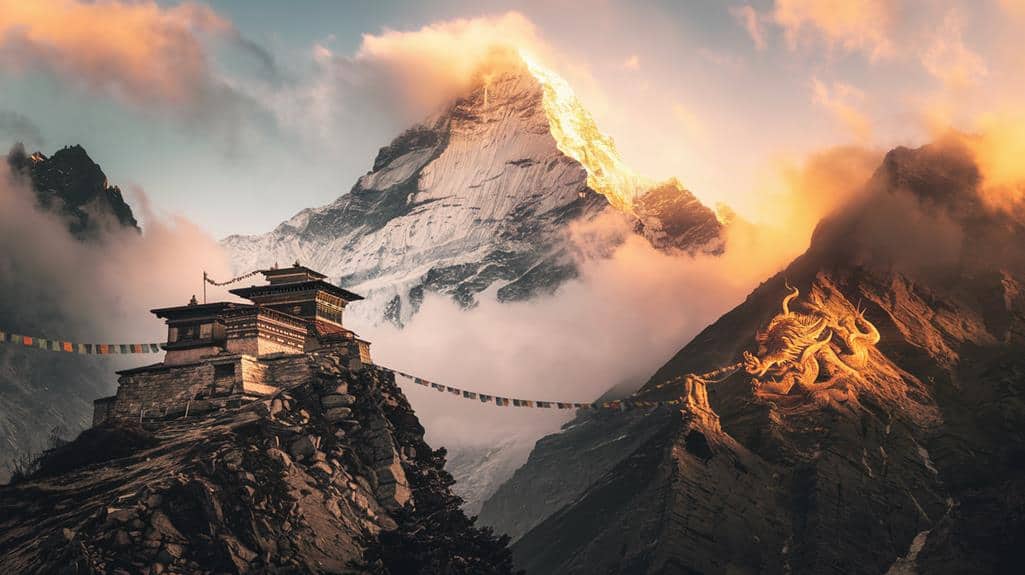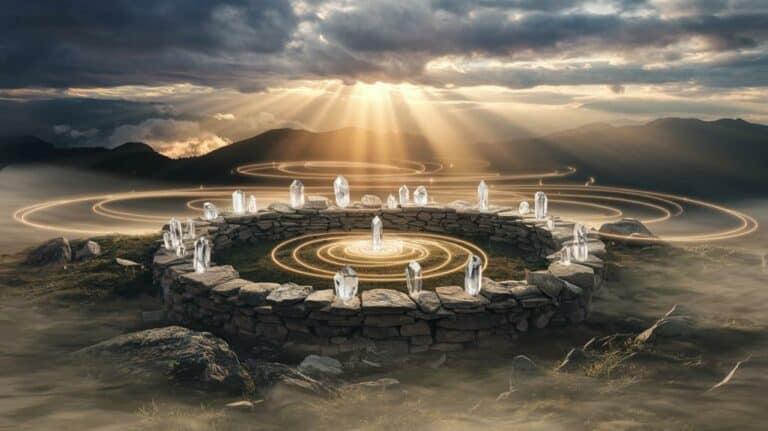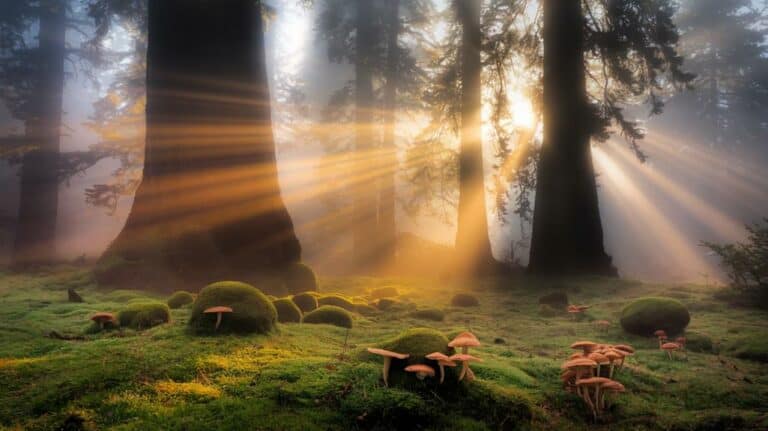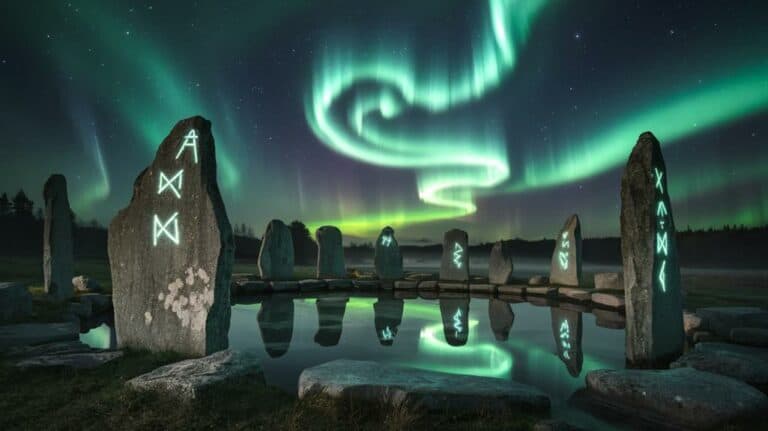12 Sacred Mountains and Their Legends
You’ll find that sacred mountains have shaped humanity’s spiritual journey since time immemorial, standing as silent witnesses to countless prayers, rituals, and transformative experiences. These towering peaks don’t just dominate landscapes; they’ve become powerful symbols in religious texts, cultural traditions, and ancient mythologies across continents. From the snow-capped summit of Japan’s Mount Fuji to the rust-colored monolith of Australia’s Uluru, each mountain holds secrets and stories that continue to draw pilgrims and truth-seekers. Let’s explore these majestic guardians of faith and discover why they’ve captured human imagination for thousands of years.
Mount Fuji
Majesty defines Mount Fuji, Japan’s tallest peak at 12,388 feet. You’ll find yourself drawn to its perfect symmetry, a volcanic cone that’s awakened something sacred in human hearts for countless generations. As you gaze upon its snow-capped summit, you’re connecting to the same profound wonder that’s inspired centuries of poets, artists, and pilgrims.
You’ll discover that Fuji-san, as it’s respectfully known, isn’t just a mountain – it’s the embodiment of Japan’s spiritual essence. Ancient Shinto beliefs hold that kami (divine spirits) dwell within its slopes, while Buddhist traditions see its peak as a gateway to enlightenment.
When you’re standing at its base, you’ll understand why climbing Fuji isn’t merely a physical journey; it’s a transformative ritual that’s called to seekers for over a millennium.
In the mountain’s presence, you’ll feel the weight of its legends: the tale of the Buddha’s fire-quenching jewel buried at its peak, the story of Princess Konohanasakuya’s eternal watch over the land, and countless personal narratives of transformation that continue to unfold on its sacred slopes.
Mount Olympus
While Mount Fuji embodies Japan’s spiritual heart, Greece’s Mount Olympus stands as the legendary home of the ancient gods. You’ll find this majestic peak rising 9,570 feet above the Aegean Sea, its limestone cliffs and deep gorges shrouded in mists that once concealed divine assemblies.
In Greek mythology, you’d have encountered Zeus and his pantheon here, ruling from their celestial throne above mortal domain. As you contemplate Olympus’s rugged slopes, you’re connecting with millennia of human yearning to reach beyond earthly constraints.
The mountain’s multiple peaks pierce the clouds like divine fingers touching the heavens, while its name itself means “the luminous one.” You’re walking in the footsteps of ancient Greeks who believed the mountain’s often-obscured summit proved the gods’ presence, hidden from mortal eyes by perpetual clouds and storms.
Today, you can still sense this sacred aura as you traverse the mountain’s ancient paths. Every weathered rock and shadowed ravine holds echoes of mythological tales, reminding you that Olympus isn’t just a mountain – it’s humanity’s enduring symbol of divine aspiration and celestial power.
Mount Kailash
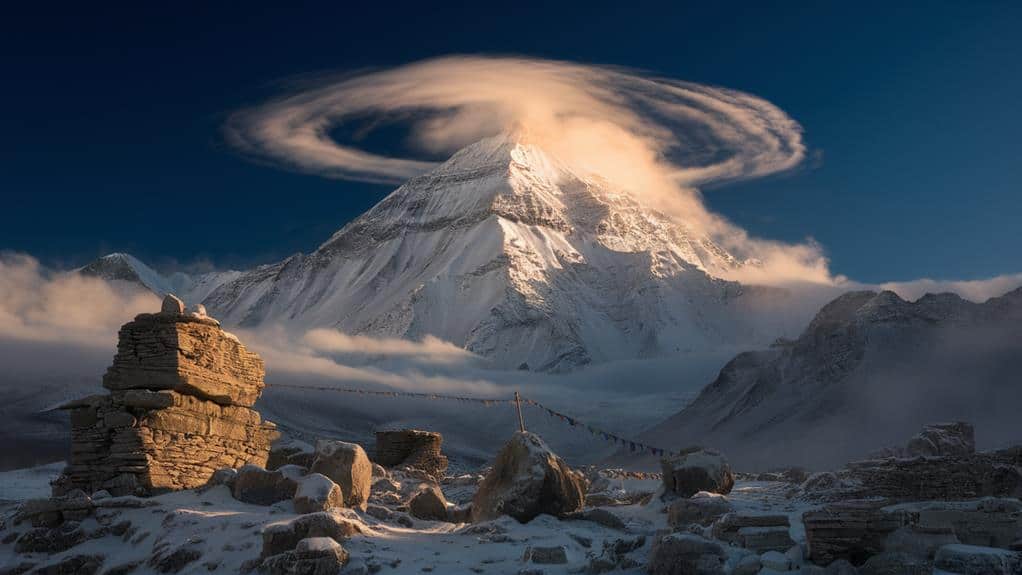
Deep within the Tibetan Himalayas stands Mount Kailash, a striking black peak that four major religions – Hinduism, Buddhism, Jainism, and Bon – consider supremely sacred.
You’ll find pilgrims from across Asia circling this cosmic axis in a ritual known as kora, believing that 108 circumambulations will lead to enlightenment. At 22,028 feet, you’re gazing upon what many consider Lord Shiva‘s earthly throne, where heaven meets earth in perfect symmetry.
You won’t find any recorded successful ascents of Kailash – it remains unclimbed out of religious respect.
The mountain’s four faces align perfectly with the cardinal directions, each bearing distinctive features that’ve inspired centuries of mythology. From the south face’s distinctive vertical line of rock, said to resemble a spiritual stairway, to the peculiar circular patterns on the north face that mirror the sun and moon, you’re witnessing nature’s own temple.
When you’re standing before Kailash, you’ll understand why it’s called the “precious jewel of eternal snow.”
The mountain doesn’t just dominate the landscape; it commands your soul’s attention, drawing you into contemplation of life’s deepest mysteries.
Mount Sinai
Sacred mysteries surround Mount Sinai, where Moses is said to have received the Ten Commandments from God. You’ll find this majestic peak rising from Egypt’s rugged landscape, its weathered slopes bearing witness to one of humanity’s most profound spiritual encounters.
When you stand at its base, you can’t help but imagine the ancient Israelites gathering here, awaiting divine revelation amidst thunder and lightning. As you ascend the mountain’s 7,497-foot height, you’re following the footsteps of countless pilgrims who’ve sought connection with the divine.
The mountain’s actual location remains debated – some scholars identify it as Jebel Musa, while others point to nearby peaks. Yet it’s the mountain’s spiritual significance that continues to draw you in, transcending geographical precision. You’ll discover three major religions – Judaism, Christianity, and Islam – all revering this sacred site.
At dawn, when the sun’s first rays paint the rocky terrain in gold, you’ll understand why this mountain has captured humanity’s imagination for millennia. It’s here that heaven and earth converged, where divine law met human consciousness, forever changing the course of religious history.
Uluru
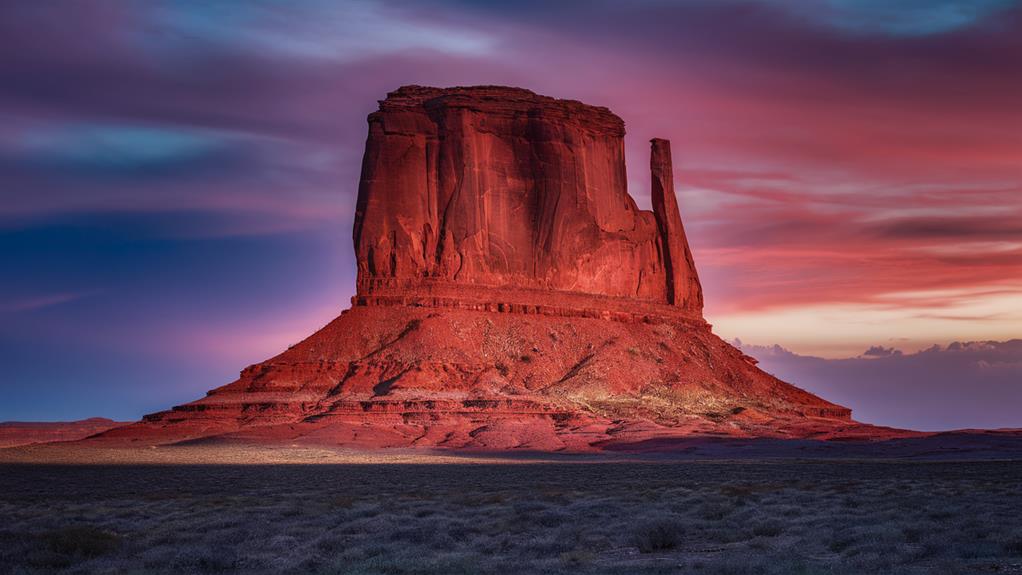
Rising majestically from Australia’s red center, Uluru stands as an iconic symbol of Aboriginal spirituality and culture. You’ll find this massive monolith changing colors throughout the day, from deep russet at dawn to blazing copper at sunset, reflecting the ancient heartbeat of the continent itself.
It’s a place where you can feel the weight of 60,000 years of indigenous history coursing through the rock’s weathered surface.
As you walk around its base, you’ll discover the sacred sites where the Anangu people have passed down their Tjukurpa (ancestral stories) through generations. The rock’s surface tells tales through its caves, waterholes, and ancient rock art, each feature holding profound spiritual significance.
You’re walking in the footsteps of countless ceremonies and rituals that have shaped Aboriginal law and culture.
You’ll notice that many locals choose not to climb Uluru, respecting its sacred status in Anangu tradition. Instead, they’ll invite you to experience the monolith’s power from the ground, where you can witness its transformation through light and shadow, connecting with one of Earth’s most spiritually charged landscapes.
Mount Kilimanjaro
Looking out over Tanzania’s vast plains, Mount Kilimanjaro soars to an impressive height of 19,341 feet, making it Africa’s tallest peak and the world’s highest free-standing mountain.
You’ll discover that the local Chagga people have long revered this majestic mountain as the sacred dwelling place of their creator god, Ruwa, who they believe sends life-giving water down from the glaciated summit to nourish their lands below.
As you approach the mountain’s base, you’ll sense the profound spiritual energy that’s drawn countless pilgrims throughout the centuries.
Ancient legends tell of mysterious lights that dance across the peak at night, believed to be the spirits of ancestors keeping watch over their descendants.
The mountain’s three volcanic cones – Kibo, Mawenzi, and Shira – stand as silent sentinels of time, while the rapidly retreating glaciers serve as stark reminders of nature’s impermanence.
When you’re standing in Kilimanjaro’s mighty shadow, you’ll understand why generations of East Africans have passed down stories of its mystical powers, viewing it not merely as a mountain, but as a bridge between Earth and Heaven.
Mount Everest
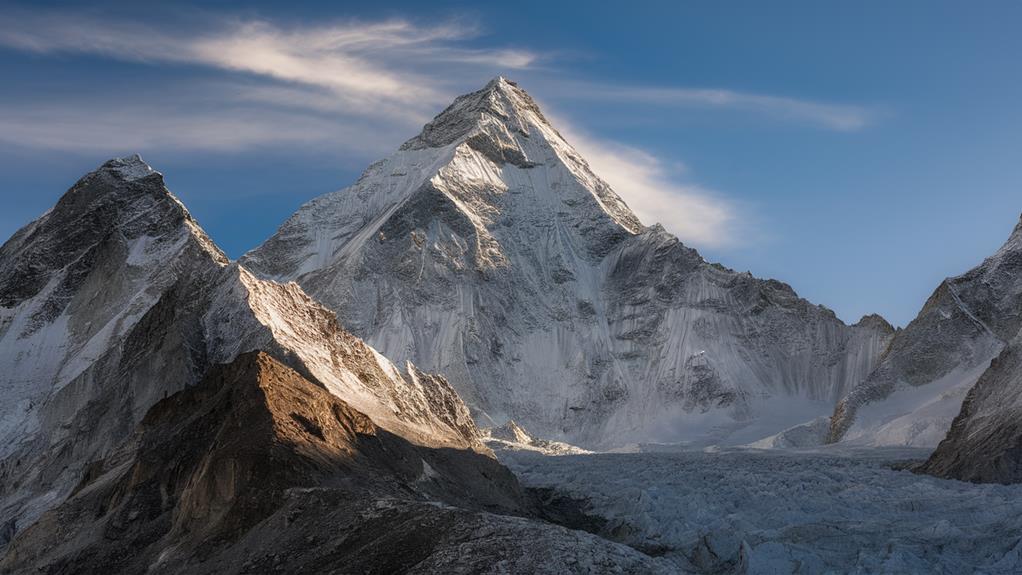
From its perch between Nepal and Tibet, Mount Everest reaches a staggering 29,029 feet into the sky, crowned as Earth’s highest peak. You’ll find its Tibetan name, Chomolungma, means “Goddess Mother of the World,” while the Nepali name, Sagarmatha, translates to “Goddess of the Sky.”
When you stand before this colossal monument of nature, you’ll understand why ancient peoples believed it to be the dwelling place of deities.
The mountain’s mystical significance runs deeper than its physical grandeur. You’re looking at a sacred domain where, according to Sherpa belief, the mountain goddess Miyolangsangma resides, bestowing fortune upon those who approach with reverence.
You’ll discover that Buddhist monasteries dot the surrounding valleys, their prayer flags dancing in winds that have witnessed countless spiritual pilgrimages. The mountain’s deadly beauty has claimed many lives, yet you’ll sense how it continues to draw seekers who view its summit as both a physical and spiritual apex.
In its presence, you’re reminded of humanity’s eternal quest to reach higher, to touch the divine, even as you acknowledge the profound respect this formidable peak demands.
Mount Shasta
A mystical giant in northern California, Mount Shasta stands 14,179 feet tall as one of the most spiritually significant peaks in North America.
You’ll discover that Native American tribes have long revered this dormant volcano as a sacred site where heaven meets earth, and where the Creator’s presence dwells within the mountain’s towering presence.
As you approach Shasta’s snow-capped summit, you’ll encounter a rich tapestry of legends that speak of Lemurian cities hidden within crystalline caves, mysterious lights that dance across the peak at twilight, and dimensional portals that connect our world to domains beyond.
You’ll find that countless spiritual seekers have been drawn to the mountain’s powerful energy vortexes, where they’ve reported profound metaphysical experiences and transformative visions.
Whether you’re hiking through ancient forests at its base or meditating near its pristine alpine lakes, you’ll feel the mountain’s magnetic pull – an inexplicable force that’s inspired generations of mystics, healers, and truth-seekers.
Mount Shasta continues to serve as a beacon for those who seek deeper understanding of life’s mysteries and their own spiritual nature.
Machu Picchu Mountain
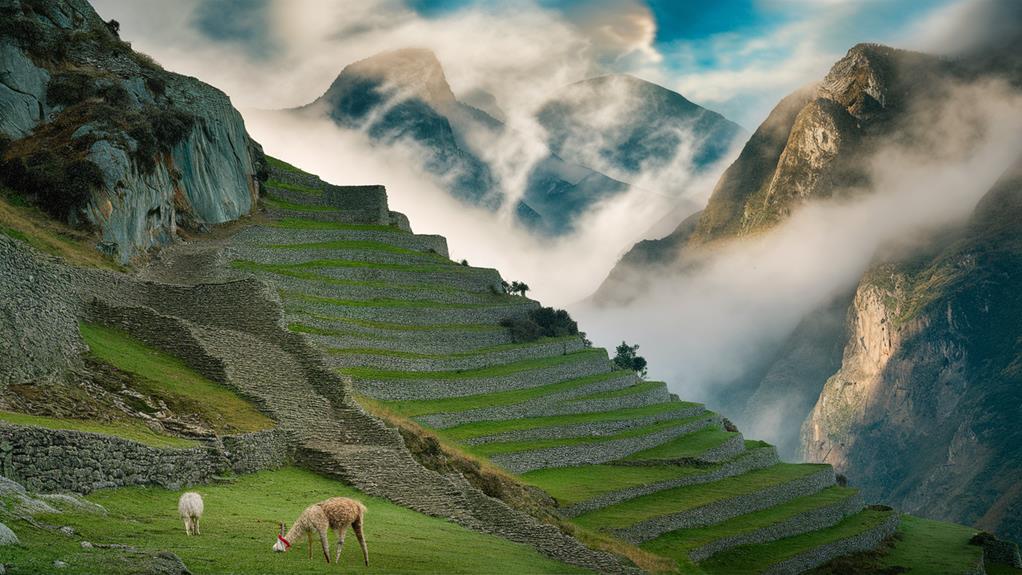
High above the ancient Incan citadel, Machu Picchu Mountain rises dramatically to 10,111 feet, offering both spiritual significance and breathtaking views of the surrounding Andean peaks.
You’ll discover a sacred domain where ancient Incan priests once performed rituals to honor Inti, their revered sun god, connecting earth to sky through ceremonial offerings and celestial observations.
As you ascend the steep, ancient stone steps, you’re walking the same path countless pilgrims have traversed before you, each footfall echoing centuries of spiritual devotion.
The mountain’s energy seems to pulse through the mist-shrouded peaks, where the boundaries between physical and spiritual domains grow increasingly thin.
At the summit, you’ll find yourself suspended between earth and sky, where the Inca believed their deities once walked.
The mountain’s distinctive shape, rising like a sentinel above the ruins, continues to draw those seeking profound connections to both nature and ancestry.
You’re not just climbing a mountain; you’re ascending through layers of time, mystery, and sacred knowledge that the Inca preserved in this remarkable fusion of natural and constructed beauty.
Mount Tai
Sacred stairs ascend through misty clouds as Mount Tai, China’s most revered peak, rises majestically in Shandong Province.
You’ll find yourself walking the same path that emperors and poets have traversed for over 3,000 years, each step bringing you closer to what ancient Chinese believed was heaven’s gateway. The mountain’s 7,000 stone steps wind through temples and inscriptions that tell stories of imperial ceremonies and spiritual awakening.
As you climb higher, you’ll notice the ancient characters carved into the cliff faces – evidence to countless pilgrims who’ve sought enlightenment here.
The mountain’s five peaks pierce the clouds at 5,069 feet, where you’ll discover the Azure Clouds Temple, a sanctuary that’s witnessed countless sunrise ceremonies.
At the summit, you’re standing where generations have contemplated their connection to the divine, where China’s rulers once performed the sacred Feng sacrifice to heaven.
You’re experiencing more than just a mountain – you’re ascending through layers of history, philosophy, and spirituality that have shaped Chinese civilization.
Here, between earth and sky, you’ll find yourself contemplating your own place in the vast cosmos.
Adam’s Peak
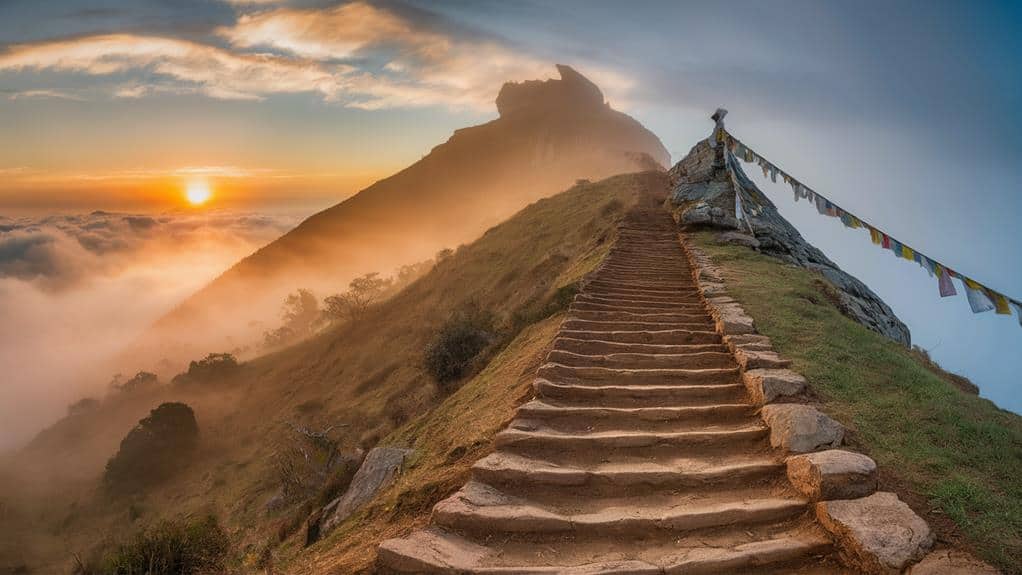
While Mount Tai connects Chinese pilgrims to heaven, Sri Lanka’s Adam’s Peak draws followers from four major religions to its distinctive summit.
You’ll find Buddhists venerating Buddha’s footprint, Hindus honoring Shiva’s mark, Muslims recognizing Adam’s first step after paradise, and Christians following the path of St. Thomas – all on this same sacred mountain that pierces the island’s misty heights.
As you ascend the 5,500 steep steps in pre-dawn darkness, you’re following ancient footsteps that stretch back over a thousand years.
The mountain’s perfect triangular shadow, cast across the landscape at sunrise, reminds you of your own brief presence in an eternal story.
You’ll notice how the simple metal chains, worn smooth by countless hands, guide pilgrims of all faiths toward the sacred depression at the peak – a reflection of humanity’s shared spiritual yearning.
In this rare convergence of faiths, you’ll discover how a single mountain can transcend religious boundaries, offering each seeker their own truth while maintaining its timeless mystery.
The peak doesn’t discriminate; it welcomes all who dare to climb toward enlightenment.
Mount Teide
Rising from the Atlantic Ocean, Spain’s Mount Teide dominates the island of Tenerife with its snow-capped peak and otherworldly volcanic landscape.
You’ll find yourself standing before an ancient guardian, a mountain that’s played a central role in the spiritual beliefs of the indigenous Guanches people, who called it Echeyde – the dwelling place of Guayota, their dark god of evil and destruction.
As you ascend through the lunar-like terrain, you’re walking the same paths where countless generations have sought connection with forces beyond human comprehension.
The mountain’s presence in Guanche mythology tells of a time when Guayota kidnapped the sun god Magec, imprisoning him within the mountain until the supreme god Achamán intervened, freeing Magec and trapping Guayota inside Teide’s crater.
Even today, you can sense this eternal struggle in the steam that rises from the volcano’s fumaroles, a reminder that beneath your feet, primordial forces continue their ancient dance.
The mountain’s peak, reaching 12,198 feet into the heavens, serves as a bridge between Earth and sky, where you’ll feel suspended between two worlds.



